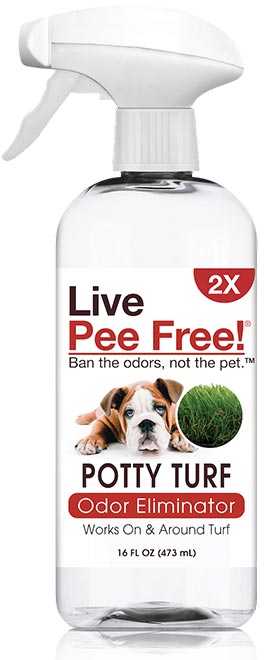Artificial grass is a popular option among pet owners.
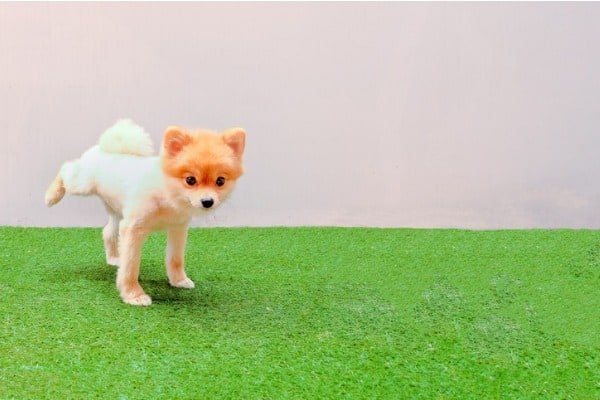
It doesn’t get damaged like natural grass does, it’s easier to maintain, and it looks as good as a living lawn if you spring for the good stuff.
Turf is also commonly used on dog lawns, pads, or “pet patches.”
Does that mean it’s maintenance-free?
Not quite.
If you have turf in place of grass, you’ll know it still requires some cleaning. It doesn’t repel leaves any better than actual grass, and the same goes with dog waste and a smelly backyard.
So how exactly do you deal with dog urine on an artificial lawn or indoor dog lawn?
Does artificial turf and dog urine pose some issues when it comes to cleaning?
Unlike carpet, urine on turf won’t raise the problem of unsightly stains.
Unlike real grass, it won’t cause yellow spots or patches of fried grass on your lawn.
The biggest job you’ll have on your hands is to neutralize dog urine on artificial grass – or, more specifically, the odors that come with urine.
Luckily, that’s a pretty easy job with more than one solution. We’ll cover it all below!
Here’s the Low-Down on Dog Urine and Turf
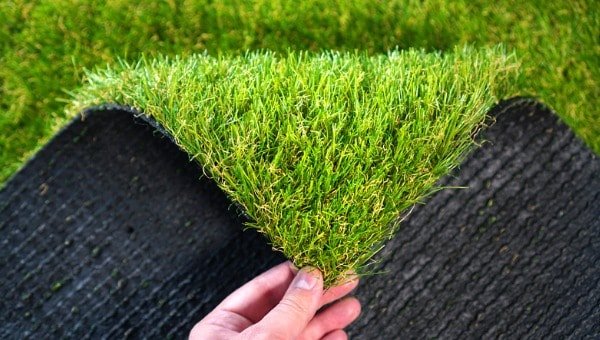
Artificial turf is popular in climates where lawns are difficult to grow or keep alive.
Desert dwellers will understand the allure of fake grass.
They’re also good options for people who don’t have the time or energy to maintain a real grass yard.
Artificial turf is a component in many dog lawns – the dog equivalent to a litter box.
With turf in your backyard, it needs attention similar to actual grass – minus the mowing and watering.
This means that, like real grass, sometimes turf can smell of dog urine.
Dog lawns need more frequent cleaning, as they’re small – and their sole purpose is a restroom for your dog.
The strategy for cleaning turf in either situation is the same. It’s also very close to the cleaning method I would recommend for urine-stained carpet, wood flooring, and tile.
Do you need anything special to clean turf?
A solution of equal parts water and vinegar can help neutralize smells at first. But you need more, which you’ll see below!
On a large area of artificial turf, rinsing it regularly will help you stay ahead of urine smells before they get out of control.
For concentrated spots, dog lawns, and extra-smelly areas, I recommend using either an ion-based urine odor remover or an enzyme cleaner.
Follow These 3 Steps for How to Clean Artificial Grass of Dog Urine
For your cleaning project, you could use vinegar and water as a preliminary cleaning method. While this might seem like a good start, it my experience will not quite cut it to rid the smell entirely.
For that, you’ll need to use a scientifically formulated product made just for neutralizing urine odors.
See our comparison list of dog urine removers here. Our recommended products for artificial grass are below.
My favorite product uses positive-ion chemistry that offsets negative ions that are making the uric acid in pet urine smell so bad.
Don’t let this “technology” speak fool you. It is completely non-toxic and safe around all pets, kids, and anyone else.
Live Pee Free makes a wonderful product just for pet turfs. You simply hose down the smelly area of the turf, then pour their odor eliminator on top and saturate it.
This stuff works on contact, so you know right away that it’s working. I love that about this product!
If you have an old, stubborn stain or one that you’ve tried unsuccessfully before to get out with other cleaners, you may have to apply the product a second time.
Let it dry, and you’re done.
If for whatever reason, you decide you don’t like the results, Live Pee Free will give you a refund, no questions asked. Their support is great though, so if you do have questions, they are there.
Here is the product I recommend:***For 20% OFF use coupon code: PEE FREE!
For the initial vinegar cleaning and the enzymatic one, you don’t need much in terms of supplies.
Both can be used as an artificial grass cleaner without getting any dangerous chemicals involved.
You’ll want to apply the enzyme cleaner using a heavy-duty spray bottle, allowing you to deliver an even coating without wasting the product.
1. Get Prepared
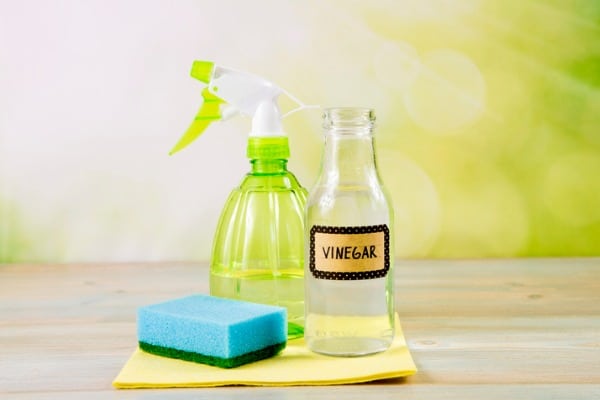
If using vinegar as your first step, mix white distilled vinegar and water in the spray bottle. When using an enzyme cleaner, you can dilute it as well.
2. Apply the Cleaner
Once you’ve rinsed everything, spray your enzyme cleaner on the affected area.
The hands-down best enzyme cleaner you should use is: BioTurf Artificial Cleaner and Odor Eliminator.
This is an enzyme concentrate that yields four 32oz bottles – enough to cover 6000 square feet of turf.
You will simply mix 1-4 oz of enzyme cleaner per gallon of water.
I like to give the affected areas a water rinse before applying the enzyme cleaner.
Using water outdoors on urine spots is much more sensible, as it will drain into the ground below.
By rinsing with water, you’re getting rid of some of the smell – meaning you won’t need to saturate the area with an enzyme cleaner to neutralize it.
The water will also help keep the enzymes active so they can finish the job.
If you have a dog lawn with a removable patch of turf, you can spray it with a hose somewhere outdoors.
For a larger area in need of treatment, you’ll want to use a cleaner with hose attachments.
BioTurf also comes with a hose-attachment option as well.
This is the way to go for treating a bigger yard with a hose-adaptable bottle.
3. Let It Dry!
Allow the area to dry. If you’re treating a piece of artificial turf from a dog lawn, it’s helpful to let it dry outdoors before replacing it back where you use it.
If you need to replace it quickly or you’re worried your dog may not like that it’s wet or damp, hang it over a fence in the bright sun. A little breeze and direct sunlight will dry it up pronto!
Preventive Advice for Artificial Grass and Odors
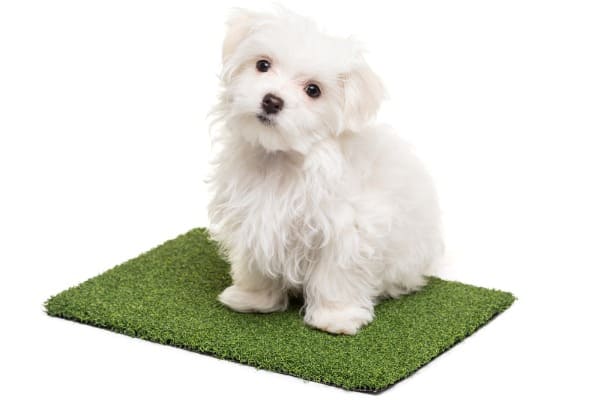
Yards and dog lawns are the designated areas for dogs to use the restroom.
So preventing them from urinating there isn’t on the list.
Preventing smells is much more doable. Artificial grass that stinks of dog pee isn’t ideal, whether it’s outside or not.
The best advice I have?
Clean your turf on a regular basis.
If you wait until the artificial turf smells like urine or the smells are overwhelming, it will take more time and effort to clean it.
See also:
- Urinary Care Dog Food: Top 5 Diet Options for Optimal Urinary Health
- My Dog Smells Like Urine! Let’s Solve This
- How Long Can a Dog Go without Peeing: 7 Healthy Answers
- Is Dog Urine Harmful to Humans: Answers You Should Know
Rinsing your yard with water once a week is wise, whether it’s made of fake grass or real.
Diluting and washing away leftover urine will go far in keeping the smells at a minimum.
If you have a heavy rainstorm, you might notice your yard smells better afterward.
This is due to the rainwater rinsing away and draining off excess urine.
A well-timed downpour can help your turf. But unless you can set your watch by the weather, a hose or sprinkler will need to take over in between storms.
And for delicate dog lawns?
Dog lawns will need cleaning more frequently – especially if you rely on them the majority of the time for your dog’s bathroom needs.
If your dog is using an artificial turf dog lawn daily, you’ll need to give it a complete rinse several times a week.
Another thing to keep in mind – particularly if you find the smells overbearing – is to ensure proper drainage underneath the turf.
What’s more…
If your turf is placed directly above concrete, the urine won’t have many places to drain off, and it will sit in the turf and stink.
Turf on lawns should have a base layer beneath them. This base, made up of sand and gravel, not only helps keep things level – it provides an ideal layer for water to drain.
Like rainwater, urine should soak through the turf, into the base layer, and eventually into the soil.
Hopefully, you know the turf’s ins and outs before starting a DIY project.
But if you have dogs, remember that installing turf over stone, driveways, or sidewalks can set you up for smelly problems down the road.
Older turf might need to be replaced or the base layer be replaced if there are recurring issues with drainage.
Dog urine doesn’t necessarily subtract from the lifespan of turf. It’s designed to survive the outdoors and all sorts of weather.
So if your turf does need replacing, don’t blame the dog.
Recommended Products
Simple Green Outdoor Odor Eliminator
This user-friendly enzyme cleaner is ideal for covering large areas, thanks to the hose attachment.
It’s safe and natural – no toxic chemicals to worry about exposing your pets and family to.
And although it’s an excellent choice for turf, it’s also safe on real grass and even indoor surfaces.
BioTurf Artificial Turf Cleaner and Odor Eliminator
If you’re looking for something specifically designed to be used on turf, look no further.
A gallon of enzyme concentrate might seem like overkill, but it’s a product worth having handy if you have multiple pets.
Don’t let the label stop you from trying this cleaner on decks, inside kennels, or on garage floors – it works just about anywhere you might find a urine stain.
Final Words…

Enzyme cleaners are the most effective option for cleaning up pet urine stains and odors. Anyone who has a pet will be glad they keep a bottle under their sink.
The versatility of enzyme cleaner is part of what makes it so effective.
Turf is an excellent surface to treat with an enzyme cleaner, but you can also use it on the carpet, urine-soaked hardwood floors, laminate, tile floors, upholstery, subfloors – the list goes on.
The steps of using enzyme cleaner to eliminate urine smells from artificial grass are very easy and quick.
When using it to clean a urine accident indoors, more steps will be involved – and you won’t have the option of taking your hose to the living room carpet before treating the spot.
But it’s still a simple and effective solution.
So that enzyme cleaner you have for your turf just might save your floor one day – or your mattress.
FAQs about Cleaning Dog Urine off Artificial Grass
How safe is enzyme cleaner?
Enzyme cleaners are the mildest cleaner you can use on pet stains while still being powerful. This doesn’t mean you or your dogs want to ingest it or get it in your eyes.
However, breathing it isn’t harmful the way bleach or ammonia-based cleaners are.
You’ll want treated surfaces to dry before you or your dog come into contact with them – but once they’re dry, they’re considered safe for dogs and people alike.
Does enzyme cleaner discolor artificial turf?
Most enzyme cleaner brands will recommend a spot test in an obscure spot – just to be sure your particular turf won’t react poorly.
But in general, enzyme cleaners contain no elements that should lift color, bleach, or otherwise alter the appearance of your turf.
The same goes for carpeting, wood flooring, laminate, tile, and upholstery. When in doubt, spot test.
But don’t worry about bleach-like effects wherever you treat with an enzyme cleaner.
Does enzyme cleaner work on cat urine?
It definitely works to eliminate cat odors. And other organic stains, for that matter.
Vomit and fecal accidents – and their subsequent smells – can be treated with an enzyme cleaner the same way urine stains can.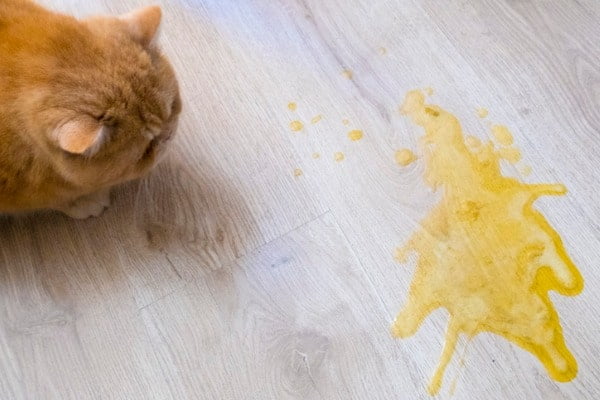
When is the best time to treat artificial grass with enzyme cleaner?
Cooler temperatures are the best for treating anything with enzyme cleaners.
High heat and prolonged exposure to sunlight can “kill” some of the enzymes, rendering the cleaner less effective.
If you’re in a hot, dry, or sunny climate, it’s best to apply the enzyme cleaner at night.
Keeping the area wet will also help keep the enzymes active for a more extended period.
It’s Not Tough to Clean Turf
Dog parents are understandably concerned about how to keep their turf clean and smell-free.
And if you have a dog lawn for your pet, you know how important it is to keep things hygienic.
To neutralize dog urine on artificial grass, you need a few things you’ve probably already used on accidents inside – if you have a puppy, you’re even more likely to have the needed tools on hand.
Vinegar and water can be a useful cleaner. In between treating artificial turf, remember to rinse.
An enzyme cleaner is best to treat turf for pesky urine smells. You might find it rescues more than just your lawn, too.

